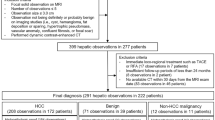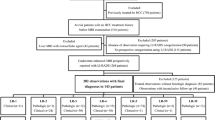Abstract
Background and purpose
Imaging-based diagnostic systems play important roles in hepatocellular carcinoma (HCC). We aimed to compare the diagnostic performance of recently updated imaging criteria for HCCs ≤ 3.0 cm on gadoxetate disodium-enhanced magnetic resonance imaging (MRI).
Methods
493 nodules (399 HCCs, 24 other malignancies, 70 benign) 1.0–3.0 cm from 400 patients, including 322 male (mean age 59.3 ± 9.4 years) and 78 female (mean age 61.2 ± 9.0 years), at risk for HCC who underwent gadoxetate disodium-enhanced MRI between July 2015 and December 2016 were retrospectively evaluated. Final diagnosis was determined histopathologically or clinically. The sensitivity and specificity in diagnosing HCC of the latest versions of four imaging criteria [Liver Imaging Reporting and Data System (LI-RADS), European Association for the Study of the Liver (EASL), Asian Pacific Association for the Study of the Liver (APASL), Korean Liver Cancer Association-National Cancer Center (KLCA-NCC)] were compared using generalized estimating equations.
Results
In 331 only pathologically diagnosed nodules, the sensitivities of both the APASL (86.8%) and KLCA-NCC criteria (85.4%) were significantly higher than the sensitivities of the EASL (71.8%) and LR-5 (71.1%) criteria (p < 0.001 for each pairwise comparison). However, the specificity of LR-5 was significantly higher than that of APASL (92.2% vs. 70.6%, respectively; p = 0.011) but did not differ significantly from the specificities of EASL (84.3%; p = 0.634) and KLCA-NCC (78.4%; p = 0.107).
Conclusion
Of the four international imaging criteria, LI-RADS and EASL showed high specificity but suboptimal sensitivity for diagnosing HCCs ≤ 3 cm. However, APASL and KLCA-NCC had a higher sensitivity but a lower specificity than LI-RADS and EASL.



Similar content being viewed by others
Abbreviations
- HCC:
-
Hepatocellular carcinoma
- APASL:
-
Asian Pacific Association for the Study of the Liver
- LI-RADS:
-
Liver Imaging Reporting and Data System
- AASLD:
-
American Association for the Study of Liver Disease
- EASL:
-
European Association for the Study of the Liver
- KLCA-NCC:
-
Korean Liver Cancer Association-National Cancer Center
- TACE:
-
Transcatheter arterial chemoembolization
- RFA:
-
Radiofrequency ablation
- CCC:
-
Cholangiocarcinoma
- BCLC:
-
Barcelona Clinic Liver Cancer
References
Choo SP, Tan WL, Goh BKP, Tai WM, Zhu AX. Comparison of hepatocellular carcinoma in Eastern versus Western populations. Cancer 2016;122:3430–3446
Llovet J, Ducreux M, Lencioni R, Di Bisceglie A, Galle P, Dufour J. European Association for the Study of the Liver European Organisation for Research and Treatment of Cancer: EASL-EORTC clinical practice guidelines: management of hepatocellular carcinoma. J Hepatol 2012;56:908–943
Kim TH, Kim SY, Tang A, Lee JM. Comparison of international guidelines for noninvasive diagnosis of hepatocellular carcinoma: 2018 update. Clin Mol Hepatol 2019. https://doi.org/10.3350/cmh.2018.0090 (Epub 2019 Feb 14)
Marrero JA, Kulik LM, Sirlin CB, Zhu AX, Finn RS, Abecassis MM, et al. Diagnosis, staging, and management of hepatocellular carcinoma: 2018 Practice Guidance by the American Association for the Study of Liver Diseases. Hepatology 2018;68:723–750
Omata M, Cheng AL, Kokudo N, Kudo M, Lee JM, Jia J, et al. Asia-Pacific clinical practice guidelines on the management of hepatocellular carcinoma: a 2017 update. Hepatol Int 2017;11:317–370
EASL Clinical Practice Guidelines. Management of hepatocellular carcinoma. J Hepatol 2018;69:182–236
Tang A, Cruite I, Mitchell DG, Sirlin CB. Hepatocellular carcinoma imaging systems: why they exist, how they have evolved, and how they differ. Abdom Radiol 2018;43:3–12
Tang A, Cruite I, Sirlin CB. Toward a standardized system for hepatocellular carcinoma diagnosis using computed tomography and MRI. Expert Rev Gastroenterol Hepatol 2013;7:269–279
Korean Liver Cancer Association, National Cancer Center. 2018 Korean liver cancer association-national cancer center Korea practice Gugdelines for the management of hepatocellular carcinoma. Gut Liver. 2019;13:227–299
Bruix J, Sherman M. American Association for the Study of liver D. Management of hepatocellular carcinoma: an update. Hepatology 2011;53:1020–1022
American College of Radiology (ACR). Liver Imaging Reporting and Data System version 2018. ACR web site. https://www.acr.org/Clinical-Resources/Reporting-and-Data-Systems/LI-RADS. Accessed 7 June 2019
Heimbach JK, Kulik LM, Finn RS, Sirlin CB, Abecassis MM, Roberts LR, et al. AASLD guidelines for the treatment of hepatocellular carcinoma. Hepatology 2018;67:358–380
Bae SY, Choi MS, Gwak GY, Paik YH, Lee JH, Koh KC, et al. Comparison of usefulness of clinical diagnostic criteria for hepatocellular carcinoma in a hepatitis B endemic area. Clin Mol Hepatol 2012;18:185–194
Ronot M, Fouque O, Esvan M, Lebigot J, Aube C, Vilgrain V. Comparison of the accuracy of AASLD and LI-RADS criteria for the non-invasive diagnosis of HCC smaller than 3 cm. J Hepatol 2018;68:715–723
Piana G, Trinquart L, Meskine N, Barrau V, Beers BV, Vilgrain V. New MR imaging criteria with a diffusion-weighted sequence for the diagnosis of hepatocellular carcinoma in chronic liver diseases. J Hepatol 2011;55:126–132
Quaia E, Pizzolato R, De Paoli L, Angileri R, Ukmar M, Cova MA. Arterial enhancing-only nodules less than 2 cm in diameter in patients with liver cirrhosis: predictors of hepatocellular carcinoma diagnosis on gadobenate dimeglumine-enhanced MR imaging. J Magn Reson Imaging 2013;37:892–902
Kwon HJ, Byun JH, Kim JY, Hong GS, Won HJ, Shin YM, et al. Differentiation of small (≤ 2 cm) hepatocellular carcinomas from small benign nodules in cirrhotic liver on gadoxetic acid-enhanced and diffusion-weighted magnetic resonance images. Abdom Imaging 2015;40:64–75
Mitchell DG, Bruix J, Sherman M, Sirlin CB. LI-RADS (Liver Imaging Reporting and Data System): summary, discussion, and consensus of the LI-RADS Management Working Group and future directions. Hepatology 2015;61:1056–1065
Kim DH, Choi SH, Park SH, Kim KW, Byun JH, Kim SY, et al. Meta-analysis of the accuracy of liver imaging reporting and data system category 4 or 5 for diagnosing hepatocellular carcinoma. Gut 2019;68:1719–1721
Kim DH, Choi SH, Kim SY, Kim MJ, Lee SS, Byun JH. Gadoxetic acid-enhanced MRI of hepatocellular carcinoma: value of washout in transitional and hepatobiliary phases. Radiology 2019;291:651–657
Joo I, Lee JM, Lee DH, Jeon JH, Han JK. Retrospective validation of a new diagnostic criterion for hepatocellular carcinoma on gadoxetic acid-enhanced MRI: can hypointensity on the hepatobiliary phase be used as an alternative to washout with the aid of ancillary features? Eur Radiol 2019;29:1724–1732
Fowler KJ, Sirlin CB. Is it time to expand the definition of washout appearance in LI-RADS? Radiology 2019;291:658–659
Fraum TJ, Tsai R, Rohe E, Ludwig DR, Salter A, Nalbantoglu I, et al. Differentiation of hepatocellular carcinoma from other hepatic malignancies in patients at risk: diagnostic performance of the liver imaging reporting and data system version 2014. Radiology 2018;286:158–172
Author information
Authors and Affiliations
Contributions
SHC and JHB contributed to study concept and design. JB and SHC acquired, analyzed, and interpreted the data. JB and SHC drafted the manuscript. JB and SHC performed statistical analysis. JHB, SJL, SYK, HJW, YMS, and PNK made critical revisions to the manuscript. JHB supervised the study.
Corresponding author
Ethics declarations
Conflict of interest
Jieun Byun, Sang Hyun Choi, Jae Ho Byun, So Jung Lee, So Yeon Kim, Hyung Jin Won, Yong Moon Shin and Pyo-Nyun Kim declare no conflicts of interest that pertain to this work.
Ethical approval
The study protocol was approved by the institutional review board of our center.
Informed consent
The need for informed consent was waived by the institutional review board of our center.
Additional information
Publisher's Note
Springer Nature remains neutral with regard to jurisdictional claims in published maps and institutional affiliations.
Electronic supplementary material
Below is the link to the electronic supplementary material.
Rights and permissions
About this article
Cite this article
Byun, J., Choi, S.H., Byun, J.H. et al. Comparison of the diagnostic performance of imaging criteria for HCCs ≤ 3.0 cm on gadoxetate disodium-enhanced MRI. Hepatol Int 14, 534–543 (2020). https://doi.org/10.1007/s12072-020-10040-2
Received:
Accepted:
Published:
Issue Date:
DOI: https://doi.org/10.1007/s12072-020-10040-2
Keywords
- Magnetic resonance imaging
- Liver
- Carcinoma, Hepatocellular
- Diagnostic imaging
- Diagnostic performance
- Diagnostic algorithm
- Liver Imaging Reporting and Data System
- European Association for the Study of the Liver
- Asian Pacific Association for the Study of the Liver
- Korean Liver Cancer Association-National Cancer Center




